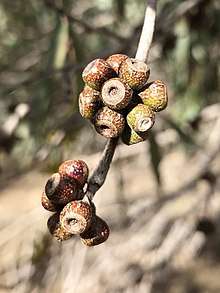Eucalyptus stellulata
Eucalyptus stellulata, commonly known as black sallee[2] or black sally,[3] is species of small tree or a mallee that is endemic to higher altitude regions of south-eastern Australia. it has rough bark on the lower part of the trunk smooth greenish bark above, lance-shaped to elliptical leaves, flower buds in group of between nine and fifteen, white flowers and cup-shaped or shortened spherical fruit.
| Black sallee | |
|---|---|
.jpg) | |
| Eucalyptus stellulata near Thredbo | |
| Scientific classification | |
| Kingdom: | Plantae |
| Clade: | Tracheophytes |
| Clade: | Angiosperms |
| Clade: | Eudicots |
| Clade: | Rosids |
| Order: | Myrtales |
| Family: | Myrtaceae |
| Genus: | Eucalyptus |
| Species: | E. stellulata |
| Binomial name | |
| Eucalyptus stellulata | |


Description
Eucalyptus stellulata is a tree or mallee that typically grows to a height of 15 m (49 ft) and forms a lignotuber. It has rough, shortly fibrous greyish bark on the lower trunk, smooth olive green bark that is somewhat oily above. Young plants and coppice regrowth have [[Sessility (botany)|sessil], elliptical leaves arranged in opposite pairs, 40–100 mm (1.6–3.9 in) long and 30–50 mm (1.2–2.0 in) wide. Adult leaves are arranged alternately, the same glossy green on both sides, lance-shaped to elliptical, 47–110 mm (1.9–4.3 in) long and 9–32 mm (0.35–1.26 in) wide tapering to a petiole 4–13 mm (0.16–0.51 in) long. The leaf veins are almost parallel. The flower buds are arranged in leaf axils in a star-like cluster of between nine and fifteen on an unbranched peduncle 1–6 mm (0.039–0.236 in) long, the individual buds sessile. Mature buds are spindle-shaped, 4–6 mm (0.16–0.24 in) long and about 2 mm (0.079 in) wide with a pointed, conical operculum. Flowering occurs between February and May and the flowers are white. The fruit is a sessile, cup-shaped or shortened spherical capsule 3–5 mm (0.12–0.20 in) long and wide with the valves near rim level.[2][3][4][5][6]
Taxonomy and naming
Eucalyptus stellulata was first formally described in 1828 by the Swiss botanist Augustin Pyramus de Candolle in his book Prodromus Systematis Naturalis Regni Vegetabilis. The specific epithet (stellulata) is derived from a Latin word meaning "little star" and refers to the appearance of the clustered flower buds.[5][7]
The Australian Oxford Dictionary gives the origin of "sally" and "sallee" as British dialect variants of "sallow", meaning "a willow tree, especially one of a low-growing or shrubby kind".[8]
Distribution and habitat
Black sallee occurs from near Tenterfield in New South Wales and southwards along the Great Dividing Range to the eastern highlands of Victoria. It is a common plant in grassy eucalyptus woodland, often near swamps and by streams. The soils are usually of a relatively good fertility.[2][3]
Gallery
- Features of the black sallee (Eucalyptus stellulata)
_-_trunk_bark_01.jpg) trunk bark
trunk bark leaves, showing sub-parallel leaf venation
leaves, showing sub-parallel leaf venation
References
- "Eucalyptus stellulata". Australian Plant Census. Retrieved 31 December 2019.
- Brooker, M. Ian H.; Slee, Andrew V. "Eucalyptus stellulata". Royal Botanic Gardens Victoria. Retrieved 31 December 2019.
- Hill, Ken. "Eucalyptus stellulata". Royal Botanic Garden Sydney. Retrieved 31 December 2019.
- A Field Guide to Eucalypts - Brooker & Kleinig volume 1, ISBN 0-909605-62-9 page 108
- "Eucalyptus stellulata". Euclid: Centre for Australian National Biodiversity Research. Retrieved 29 May 2020.
- Chippendale, George M. "Eucalyptus stellulata". Australian Biological Resources Study, Department of the Environment and Energy, Canberra. Retrieved 31 December 2019.
- William T. Stearn (1992). Botanical Latin. History, grammar, syntax, terminology and vocabulary (4th ed.). Portland, Oregon: Timber Press. p. 503.
- Moore, Bruce (ed.) (1999). The Australian Oxford Dictionary. SouthMelbourne: Oxford University Press. p. 1188. ISBN 0195507932.CS1 maint: extra text: authors list (link)